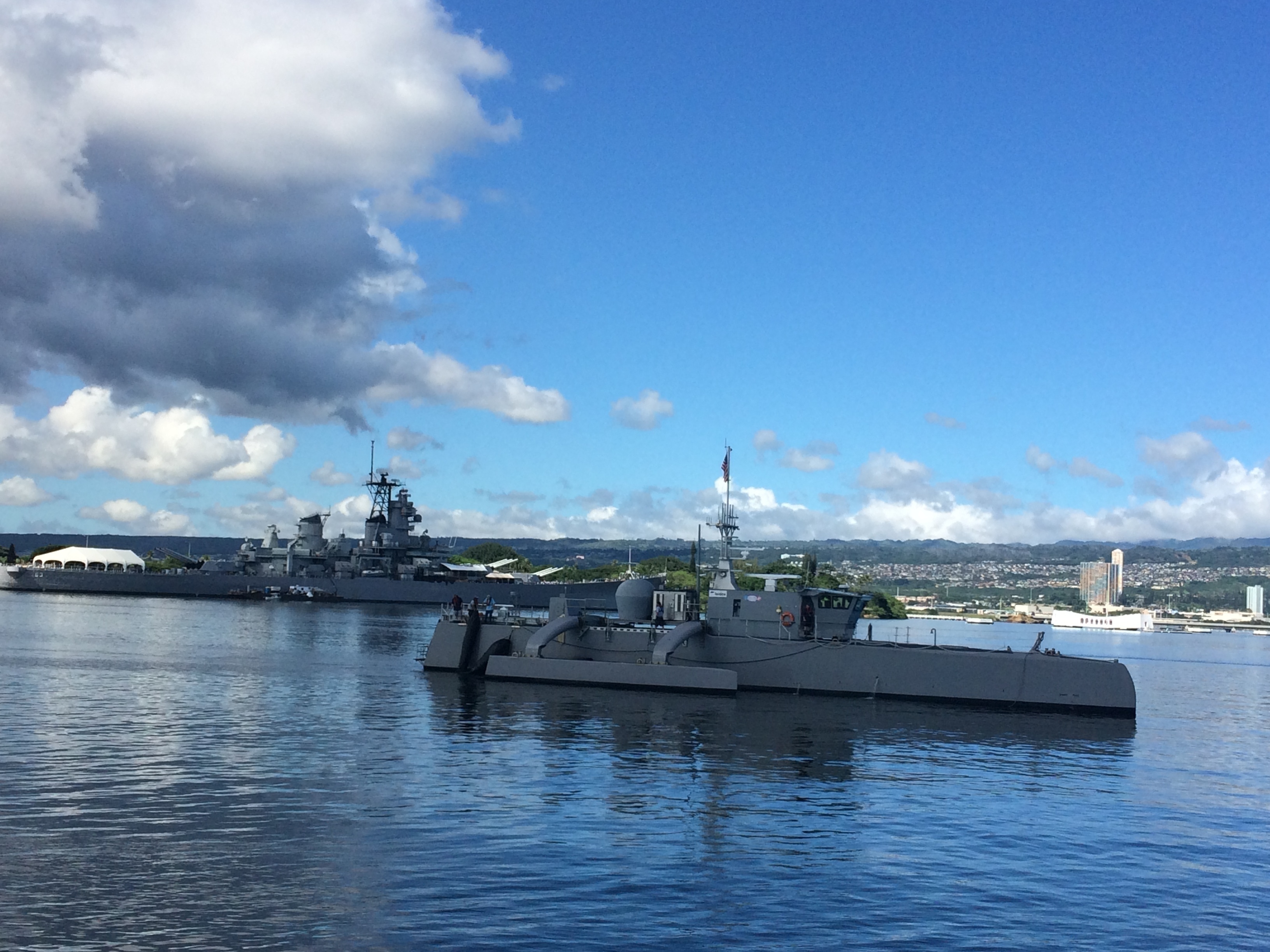
As the Pentagon prepares for a fight in the vastness of the Indo-Pacific, the Defense Advanced Research Projects Agency (DARPA) is developing a concept it hopes will allow unmanned surface vehicles to travel up to 14,000 nautical miles.
The heart of the Sea Trains program is learning how to increase the efficiency of ships by connecting the vessels in an at-sea convoy designed to limit resistance caused by waves.
“What we’re looking to do here is to demonstrate that we can get really long operational ranges out of the system through this unique configuration network that we’re focused on. So the idea here is physically connecting multiple vessels together. And that’s a way to get at the wave-making resistance that’s created by a vessel,” Andrew Nuss, DARPA’s Sea Trains program manager, told USNI News in a recent interview
“So by physically connecting four of these vessels together for the really long-range transits, you effectively have the resistance of that four-vessel system, [which] is about the same as a single vessel operating out there because that sort of first vessel is kind of the linebacker, I would say, of the wave making resistance,” he continued. “The second, third and fourth vessel on that train don’t see as much wave-making resistance as they would operating independently. So it’s kind of a unique approach to solve the problem. We’re trying to cheat physics a little bit here in reducing wave-making resistance.”
DARPA in September announced it had issued awards to three companies — Gibbs & Cox, Applied Physical Sciences Corp. and InMar Technologies — for Sea Trains. Applied Physical Sciences Corp. received a contract, while DARPA issued InMar Technologies and Gibbs & Cox other transaction authorities, according to Nuss. Each company is tackling a different approach for phase one of the program, which is slated to continue for about 18 months and will include testing scales models.
Work on the program comes as the Navy is ramping up its investment in unmanned technology and as Defense Secretary Mark Esper calls for a larger fleet of more than 500 vessels that would include a mix of both manned and unmanned platforms.
The Navy and Marine Corps, in shifting to the 2018 National Defense Strategy’s focus on great power competition with countries like Russia and China, are reassessing platforms and equipment to sketch out a future fleet architecture.
Nuss pointed to the Navy’s 3,500 nautical-mile range requirement for the Medium Unmanned Surface Vehicle the service is pursuing and noted a vessel operating in the Indo-Pacific region likely can’t reach many locations before having to refuel.
“If you start drawing that distance out in the Pacific, let’s say, there’s very few places you can go without needing to go to a port to refuel or some other at-sea refueling operation, like the Navy currently conducts, you know, 24/7 around the world right now for destroyers and other platforms,” Nuss said. “So what we identified as a risk and a vulnerability in those future operations is that if the Navy does field 100 or 150 unmanned surface vessels, the logistics to be able to support those at-sea refueling operations is going to be quite considerable.”
“So what we’re trying to do with this program is to show that there’s another way to get that size platform into theater without necessarily being as dependent on at-sea refueling or in port refueling,” he continued. “So it gives that flexibility of deploying longer-range unmanned surface vessels maybe in concert with shorter range ones or larger platforms. It really gives another option for the different mix of capabilities that could be fielded in the future.”
The Navy in July issued L3 Technologies a $35-million award to create a MUSV prototype. USNI News previously reported that the Navy is aiming for a range of at least 4,500 nautical miles for the MUSV.
“So for a four-vessel Sea Train system of the size that we specked out, carrying a payload that exceeds what the medium-sized USV program of record defines, we are looking at a 14,000 nautical mile operational range,” Nuss said of the Sea Trains program’s objectives.
“So we’re looking to increase that current program of record capability by four or five times fold, while still being an affordable platform. So we’re certainly sensitive to the cost of the platform as well. So that’s also one of the driving metrics for the program,” he added. “So that 14,000 miles — yes, you could drive the boats from one coast into an operational theater and back again without having to refuel at-sea — but really what it provides is operational flexibility. [It] gives the combatant commander the ability to move those chess pieces around on the board without having to worry about at-sea refueling every three or four days.”
DARPA is using a medium-sized USV as its base configuration for Sea Trains to allow adjustments to either smaller or larger vessels.
“We’re nominally in the 16th scale to be able to collect enough data and enough varying sea state conditions, or representative sea state conditions, to convince ourselves that the physics as we understand it, and the modeling as we understand it, actually holds in the real world, and that the concept can actually create the capability for these really long ranges that we’re looking for,” Nuss said of the first phase of Sea Trains.
Gibbs & Cox is working on the connectorless method, while InMar Technologies is developing the collaborative formation option. APS is pursuing the connected approach.
“You can think of it as a normal railroad coupler connection, so that [there is] a hard connection between vessels,” Nuss said of the connected approach.
“There’s a connectorless approach, where they might be in physical, physically, contact, but they’re not — there’s no actual sort of coupler between vessels,” he continued. “And then the third is a unique one and that is collaborative formation operation, so there’s no physical contact or touching between the vessels. This is akin to the mama duck and duckling approach, where that lead vessel is creating what we call the Kelvin wake, and the following vessels position themselves in that Kelvin wake to be able to reduce their wavelength resistance.”
DARPA left the hull design of the USVs up to the companies working on phase one, so the work could lead to options ranging from a monohull to a trimaran to a tumblehome hull.
While the focus for Sea Trains is on USVs, Nuss said the idea DARPA is exploring through the program could also apply to manned vessels.
“The concept that we’re pursuing is extensible in either smaller or longer, larger platforms, and frankly in manned and unmanned,” he said. “There’s nothing unique about what we’re doing here that requires it to be unmanned. It just happens to be — this is a nice sort of alignment to where the Navy’s investing in right now.”
Like the agency is doing with its No Manning Required Ship (NOMARS) program, Nuss said DARPA has maintained a dialogue with PMS-406 in the Navy’s program executive office for unmanned and small combatants, which he said took part in source selection for Sea Trains. PMS-406 is also overseeing the service’s pursuit of its MUSV and Large Unmanned Surface Vehicle.
While PMS-406 is the central focus for the work, Nuss said DARPA has also discussed Sea Trains and its potential with the Marine Corps. The Marine Corps has expressed interest in a Long Range Unmanned Surface Vehicle.
Nuss said a hypothetical phase two for Sea Trains would also likely take 18 months and include more than one company that could keep testing after a down-select process at the end of phase one.
“Phase two also ends in scale model testing — this time at quarter scale — and quarter scale at this size vessel we’re talking about is still quite a large boat. It’s still on the order of 10 meters at the scale level,” Nuss said.
Nuss said the quarter-scale testing for phase two would take place at sea.
“So either in Chesapeake Bay, or off the Virginia coast, or in the Gulf of Mexico or on the west coast of the U.S.,” he said. “So getting prototypes, even at a scale level out into some real operational conditions and prove – again — that the physics hold and the system can actually operate as intended.”





